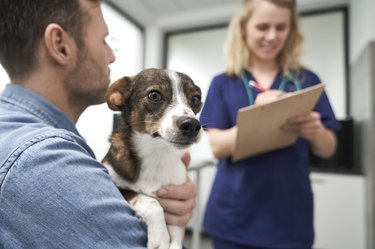Internal bleeding in dogs typically happens after a traumatic injury, such as getting hit by a car; ingesting toxins, like rat poison, that cause clotting disorders; and from benign and malignant tumors. One of the most common causes of internal bleeding is a ruptured spleen tumor, called a hemangiosarcoma. Because internal bleeding in dogs is so serious, it's important to know what to look for in an emergency situation or when your dog isn't acting right and you're unaware of them ingesting a harmful substance.

Video of the Day
Internal bleeding in dogs has several symptoms, though not all of them are immediately obvious. Unfortunately, abuse by humans and dog fights are also causes of internal bleeding in canines, so pay attention if your dog starts acting out of the ordinary after spending time with new humans or dogs when you're not present.
Video of the Day
Causes of internal bleeding in dogs
Internal bleeding can occur in dogs for many reasons. A significant trauma, such as being hit by a car, can trigger internal bleeding. Ingesting mouse or rat poison can also cause internal bleeding.
Dogs who have experienced obvious trauma may also have external bleeding, such as a laceration. If a dog is visibly bleeding, it's critical to apply pressure to the wound (if safe) to minimize the bleeding. For dogs who haven't been hit by a car or ingested poison, cancer is the most common cause of internal bleeding.
Dogs experiencing bleeding in the abdominal cavity are in a life-threatening situation and need to receive emergency veterinary care as soon as possible. You should be aware of the symptoms of internal bleeding. If you notice any of these symptoms in your dog and have reason to believe that they are experiencing internal bleeding, contact your veterinarian immediately or take your dog to the nearest emergency veterinary center.

Pale gums in dogs
A dog's gums can tell you a lot about general dog health including how well blood is flowing through their body. A healthy dog's gums should be pink, about the color of bubble gum. If your dog is experiencing internal bleeding, their gums and tongue may be a pale pink to white color because less blood is circulating through them.
You can also test your dog's capillary refill time. Press a finger against your dog's gums and then quickly release it. A healthy dog's gums will return to their normal pink color within two seconds. If it takes more than two seconds for the color to return in the area that you've pressed, this could indicate shock due to internal blood loss.
Shock, lethargy, and discomfort in dogs
One of the signs of internal bleeding is that your dog may become lethargic and weak because of anemia. Internal blood loss causes your dog to be weak and to have low energy. Your dog may also feel uncomfortable and in pain, but weakness and reluctance to move around or walk may be one of the most prominent symptoms.
Because internal bleeding decreases the volume of blood in your dog's circulatory system, shock can set in. Symptoms of shock in dogs include low blood pressure, decreased body temperature, cold legs, increased heart rate, and a weak pulse.

A dog's enlarged abdomen
When a lot of blood pools into your dog's abdomen, their abdomen may appear to be enlarged. You may also notice that the skin near your dog's belly develops a dark hue, red and purple splotches, or small red dots if their bleeding is caused by a clotting deficiency.
First aid for internal bleeding in dogs
If you suspect your dog is bleeding internally, then it's important to act quickly since this is an emergency. Call your veterinarian and let them know that you're on the way. Then, get your dog into the car and to the veterinarian as quickly as possible.
You should wrap your dog in a towel and speak calmly and reassuringly to them. Keep them as calm and quiet as possible. Remember that scared and injured animals, even if they are your family, can bite out of fear. Your safety is important.
When you lift your dog's body to put them in the car, don't put pressure on their abdomen. Instead, lift them with one arm under the chest and in front of the legs and put your other arm under the rump and behind the back legs. Get to the veterinarian as quickly as possible.
When you get to the veterinarian, the veterinarian will perform a physical exam. They will order X-rays, bloodwork, and an ultrasound to diagnose the problem. In severe emergencies, dogs experiencing heavy internal bleeding may also need blood transfusions. Treatment is largely dependent on the cause of the internal bleeding. Depending on the cause of the bleeding, your dog may need to be hospitalized on medications to correct clotting deficiencies or undergo surgery to stop the bleeding and remove the tumor.
The bottom line
Internal bleeding in dogs is serious. If your dog has experienced a serious injury, such as being hit by a car, or if your dog displays certain symptoms, get them to a veterinarian as soon as possible. A veterinarian can rule out internal bleeding or find it and provide treatment immediately. Older dogs are at a greater risk of internal bleeding from tumors, while dogs of all ages can be at risk of internal bleeding from trauma and toxins.